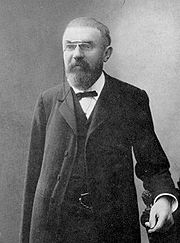Poincaré group
The Poincaré group, named after Henri Poincaré (1905),[1] was first defined by Hermann Minkowski (1908) as the isometry group of Minkowski spacetime.[2][3] It is a ten-dimensional non-abelian Lie group that is of importance as a model in our understanding of the most basic fundamentals of physics.The Poincaré group consists of all coordinate transformations of Minkowski space that do not change the spacetime interval between events.For example, if everything were postponed by two hours, including the two events and the path you took to go from one to the other, then the time interval between the events recorded by a stopwatch that you carried with you would be the same.Or if everything were shifted five kilometres to the west, or turned 60 degrees to the right, you would also see no change in the interval.It turns out that the proper length of an object is also unaffected by such a shift.In total, there are ten degrees of freedom for such transformations.They may be thought of as translation through time or space (four degrees, one per dimension); reflection through a plane (three degrees, the freedom in orientation of this plane); or a "boost" in any of the three spatial directions (three degrees).In classical physics, the Galilean group is a comparable ten-parameter group that acts on absolute time and space.Instead of boosts, it features shear mappings to relate co-moving frames of reference.In general relativity, i.e. under the effects of gravity, Poincaré symmetry applies only locally.A treatment of symmetries in general relativity is not in the scope of this article.10 generators (in four spacetime dimensions) associated with the Poincaré symmetry, by Noether's theorem, imply 10 conservation laws:[4][5] The Poincaré group is the group of Minkowski spacetime isometries.The four-dimensional abelian group of spacetime translations is a normal subgroup, while the six-dimensional Lorentz group is also a subgroup, the stabilizer of the origin.In turn, it can also be obtained as a group contraction of the de Sitter group SO(4, 1) ~ Sp(2, 2), as the de Sitter radius goes to infinity.Its positive energy unitary irreducible representations are indexed by mass (nonnegative number) and spin (integer or half integer) and are associated with particles in quantum mechanics (see Wigner's classification).In quantum field theory, the universal cover of the Poincaré group which may be identified with the double cover is more important, because representations ofmatrices with unit determinant, isomorphic to the Lorentz-signature spin group) part of the Lorentz subgroup (its identity component),In component form, the Poincaré algebra is given by the commutation relations:[7][8]The bottom commutation relation is the ("homogeneous") Lorentz group, consisting of rotations,In this notation, the entire Poincaré algebra is expressible in noncovariant (but more practical) language as where the bottom line commutator of two boosts is often referred to as a "Wigner rotation".In terms of the physical parameters, we have The Casimir invariants of this algebra areis the Pauli–Lubanski pseudovector; they serve as labels for the representations of the group.As a result, all elementary particles fall in representations of this group.In practice, charge conjugation and parity are violated by many quantum field theories; where this occurs,[9] The definitions above can be generalized to arbitrary dimensions in a straightforward manner.The d-dimensional Poincaré group is analogously defined by the semi-direct product with the analogous multiplication The Lie algebra retains its form, with indices µ and ν now taking values between 0 and d − 1.The alternative representation in terms of Ji and Ki has no analogue in higher dimensions.

Fundamental groupAlgebraic structureGroup theorySubgroupNormal subgroupGroup actionQuotient group(Semi-)direct productDirect sumFree productWreath productGroup homomorphismssimplefiniteinfinitecontinuousmultiplicativeadditivecyclicabeliandihedralnilpotentsolvableGlossary of group theoryList of group theory topicsFinite groupsCyclic groupSymmetric groupAlternating groupDihedral groupQuaternion groupCauchy's theoremLagrange's theoremSylow theoremsHall's theoremp-groupElementary abelian groupFrobenius groupSchur multiplierClassification of finite simple groupsLie typesporadicDiscrete groupsLatticesIntegersFree groupModular groupsArithmetic groupLatticeHyperbolic groupTopologicalLie groupsSolenoidCircleGeneral linearSpecial linearOrthogonalEuclideanSpecial orthogonalUnitarySpecial unitarySymplecticLorentzConformalDiffeomorphismInfinite dimensional Lie groupAlgebraic groupsLinear algebraic groupReductive groupAbelian varietyElliptic curveHenri PoincaréHermann Minkowskiisometry groupnon-abelianLie groupphysicscoordinate transformationsMinkowski spaceeventsproper lengthdegrees of freedomrotationsclassical physicsGalilean groupabsolute time and spaceshear mappingsgeneral relativitygravityspecial relativitytranslationsabelian Lie groupthree-dimensional rotationsboostsLorentz groupLorentz invariancesemi-direct productNoether's theoremisometriesnoncompactabelian groupspacetimeaffine groupLorentz transformationssemidirect productgroup extensionrepresentationgroup contractionde Sitter radiusrepresentationsintegerquantum mechanicsWigner's classificationErlangen programhomogeneous spacequantum field theoryfermionsLie algebrasClassical groupsSimple Lie groupsOther Lie groupsConformal groupLie group–Lie algebra correspondenceExponential mapAdjoint representation